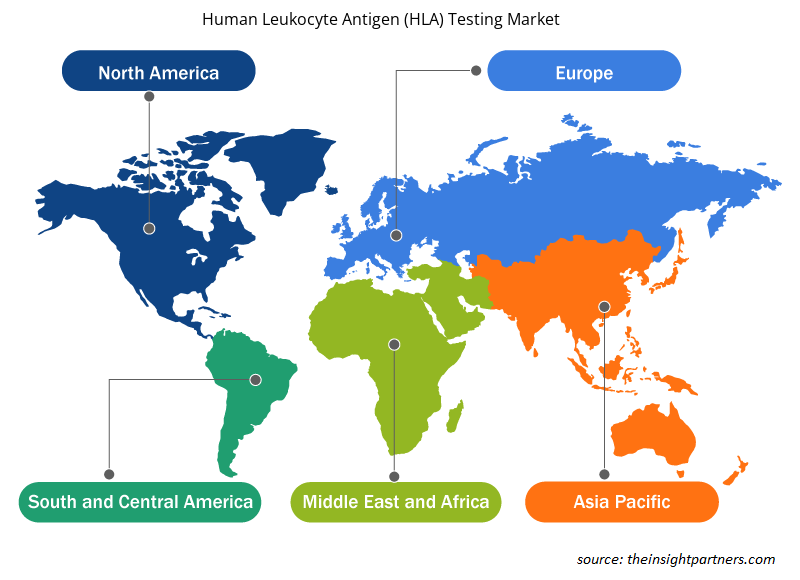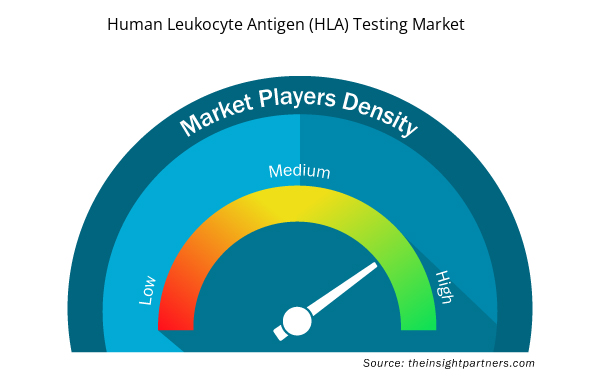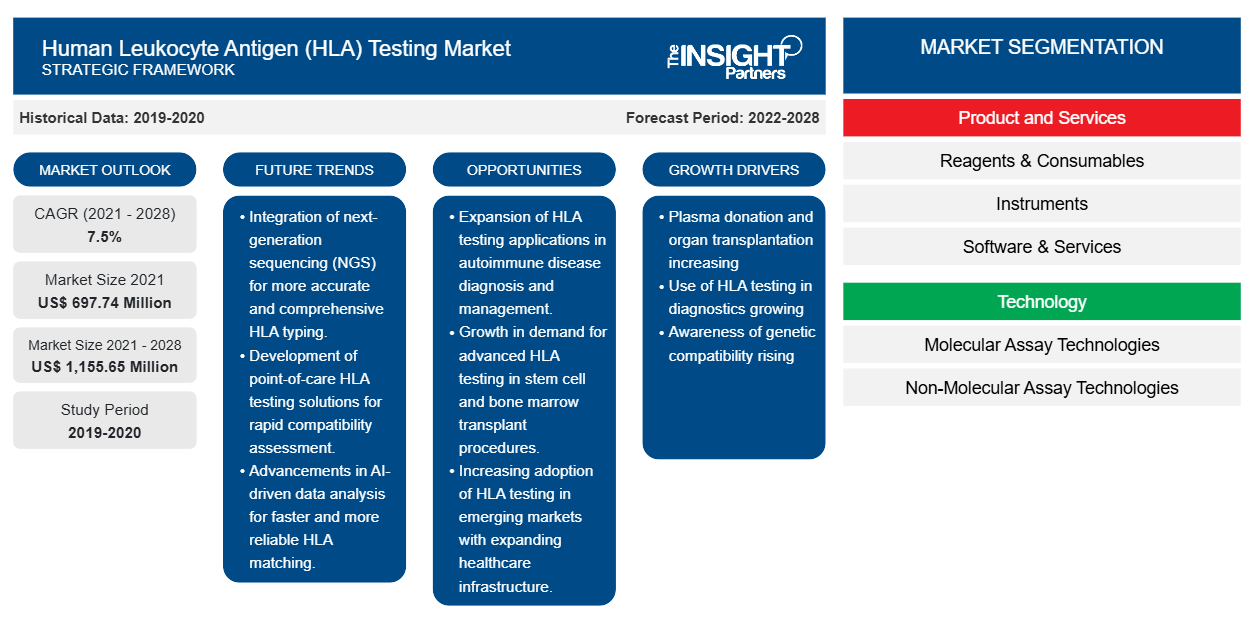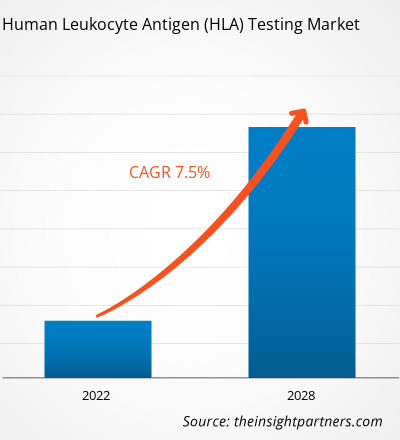Se proyecta que el mercado de pruebas de antígeno leucocitario humano (HLA) alcance los US$ 1.155,65 millones para 2028 desde los US$ 697,74 millones en 2021; se espera que registre una CAGR del 7,5% entre 2022 y 2028.
Los antígenos leucocitarios humanos desempeñan un papel esencial en la respuesta inmunitaria del organismo a las sustancias externas. El principal uso de las pruebas de HLA es emparejar a los receptores de trasplantes de órganos y tejidos con donantes compatibles. Las pruebas de HLA también implican la detección de anticuerpos en los receptores de trasplantes que podrían atacar el tejido u órgano donado como parte de una respuesta inmunitaria.
El informe ofrece información y un análisis profundo del mercado de pruebas de antígeno leucocitario humano (HLA), haciendo hincapié en las tendencias del mercado, los avances tecnológicos y la dinámica del mercado, entre otros. También proporciona el análisis del panorama competitivo de los principales actores del mercado a nivel mundial. Además, incluye el impacto de la pandemia de COVID-19 en el mercado en todas las regiones principales. La pandemia de COVID-19 creó una crisis de salud pública y una crisis económica en todo el mundo. Antes de la pandemia, el mercado de pruebas de antígeno leucocitario humano (HLA) estaba creciendo continuamente debido a la regularidad en la evaluación de los donantes de órganos, los consuelos y los tratamientos. La primera ola de COVID-19 interrumpió las consultas, los seguimientos y las pruebas de detección relacionadas con enfermedades distintas de COVID-19. Varias empresas experimentaron graves pérdidas en el último trimestre de 2019; la pandemia tuvo particularmente efectos adversos en el mercado global en el primer y segundo trimestre de 2020. Las empresas de todo el mundo se vieron obstaculizadas debido a la interrupción de las cadenas de suministro y al aumento de la demanda de productos y servicios sanitarios. Para reducir la infección por COVID-19 en hospitales y clínicas, los profesionales de la salud y los pacientes adoptaron y prefirieron tratar a sus pacientes de forma remota. Estas circunstancias imprevisibles también obstaculizaron los procedimientos de trasplante de órganos. Muchos tratamientos quirúrgicos y consultas no urgentes se cancelaron o pospusieron, y las cirugías electivas se suspendieron en muchas instituciones para limitar la propagación del SARS-CoV-2, así como para reservar y reasignar recursos, incluido el personal de atención médica (enfermeras y anestesiólogos), el equipo médico (equipo de protección personal y respiradores) y las camas. La recomendación de "quedarse en casa" resultó en una reducción significativa en las cirugías de donación y trasplante de órganos. Estas condiciones frenaron el crecimiento del mercado de pruebas de antígeno leucocitario humano (HLA) en todo el mundo en 2020.
Personalice este informe según sus necesidades
Obtendrá personalización en cualquier informe, sin cargo, incluidas partes de este informe o análisis a nivel de país, paquete de datos de Excel, así como también grandes ofertas y descuentos para empresas emergentes y universidades.
- Obtenga las principales tendencias clave del mercado de este informe.Esta muestra GRATUITA incluirá análisis de datos, desde tendencias del mercado hasta estimaciones y pronósticos.
Perspectivas del mercado
El aumento del número de procedimientos de donación de plasma y trasplante de órganos impulsa el crecimiento del mercado
Los antígenos leucocitarios humanos (HLA) son proteínas especializadas presentes en todas las superficies celulares del cuerpo humano, excepto los glóbulos rojos. Las pruebas de HLA tienen una aplicación significativa en el trasplante de órganos , que puede recomendarse como parte del tratamiento de la insuficiencia renal, la cirrosis hepática crónica y la enfermedad cardíaca crónica, entre otros problemas médicos. La creciente prevalencia de enfermedades crónicas e insuficiencia orgánica conduce a una gran demanda de procedimientos de trasplante de órganos, así como de pruebas de HLA. Antes del trasplante, se realizan pruebas de HLA para verificar la compatibilidad de tejidos entre pacientes y donantes para evitar el rechazo del injerto. En los últimos años, el trasplante se ha convertido en una práctica exitosa en todo el mundo. Según los datos publicados en el Observatorio Global sobre Donación y Trasplante (GODT), en 2020, se registraron 129.681 trasplantes de órganos en total. De estos, el 31,7% fueron trasplantes de riñón vivo y el 20,40% fueron trasplantes de hígado vivo.
Los gobiernos de varios países están tomando iniciativas para difundir la conciencia sobre la necesidad de la donación de órganos y los beneficios del trasplante de órganos en ciertos procedimientos de tratamiento. Por ejemplo, la Red de Obtención y Trasplante de Órganos (OPTN, por sus siglas en inglés) ha implementado algunas estrategias para mejorar el número de procedimientos de trasplante de órganos en los EE. UU. Estas estrategias se centran en aumentar el número de trasplantes de órganos y tejidos entre pacientes con enfermedades orgánicas en etapa terminal, alterar la distribución actual de órganos y modificar la lista de espera de trasplantes de órganos redistribuyendo la lista de espera de órganos existente. Además, la OPTN ha utilizado estrategias innovadoras para mejorar el trasplante de órganos. Estas estrategias innovadoras incluyen el uso optimizado de órganos obtenidos de pacientes fallecidos [por ejemplo, donación después de muerte cardíaca (DCD, por sus siglas en inglés) o donantes con muerte cerebral], reducir los descartes de órganos, promover la donación en vida y mejorar la tasa de autorización de donación potencial de órganos.
Por lo tanto, la creciente demanda de trasplantes de órganos conduce a la necesidad de un número mayor de kits y consumibles para pruebas de HLA, lo que impulsa el crecimiento del mercado de pruebas de HLA.
Información basada en productos y servicios
Según los productos y servicios, el mercado de pruebas de antígeno leucocitario humano (HLA) se segmenta en reactivos y consumibles, instrumentos, software y servicios. En 2021, el segmento de reactivos y consumibles tuvo la mayor participación del mercado y se espera que registre la CAGR más rápida del 7,5 % durante el período de pronóstico. HLA) testing market is segmented into reagents and consumables, instruments, and software and services. In 2021, the reagents and consumables segment held the largest share of the market, and it is expected to register the fastest CAGR of 7.5% during the forecast period.
Perspectivas basadas en la tecnología
Según la tecnología, el mercado de pruebas de antígeno leucocitario humano (HLA) se segmenta en tecnologías de análisis molecular y tecnologías de análisis no molecular. En 2021, el segmento de tecnologías de análisis molecular tuvo la mayor participación del mercado y se espera que registre una CAGR más alta del 7,7 % durante 2022-2028.HLA) testing market is segmented into molecular assay technologies and non-molecular assay technologies. In 2021, the molecular assay technologies segment held a largest share of the market, and it is expected to record a higher CAGR of 7.7% during 2022–2028.
Información basada en el usuario final
Según el usuario final, el mercado de pruebas de antígeno leucocitario humano (HLA) está segmentado en laboratorios de referencia independientes, hospitales y centros de trasplantes, entre otros. En 2021, el segmento de laboratorios de referencia independientes tuvo la mayor participación del mercado. Sin embargo, se espera que el segmento de hospitales y centros de trasplantes registre la CAGR más alta del 7,9 % durante 2022-2028HLA) testing market is segmented into independent reference laboratories, hospitals and transplant centers, and others. In 2021, the independent reference laboratories segment held the largest share of the market. However, hospitals and transplant centers segment is expected to report the highest CAGR of 7.9% during 2022–2028
Los actores del mercado de pruebas de antígeno leucocitario humano (HLA) adoptan estrategias orgánicas como el lanzamiento y la expansión de productos para expandir su presencia y cartera de productos en todo el mundo, además de satisfacer las crecientes demandas de productos.HLA) testing market players adopt organic strategies such as product launch and expansion to expand their footprint and product portfolio worldwide, along with meeting the growing product demands.
Por geografía
Según la geografía, el mercado de pruebas de antígeno leucocitario humano (HLA) está segmentado en América del Norte (EE. UU., Canadá y México), Europa (Reino Unido, Alemania, Francia, Italia, España y el resto de Europa), Asia Pacífico (China, Japón, India, Australia, Corea del Sur y el resto de Asia Pacífico), Medio Oriente y África (EAU, Arabia Saudita, Sudáfrica y el resto de Medio Oriente y África) y América del Sur y Central (Brasil, Argentina y el resto de América del Sur y Central).
Prueba de antígeno leucocitario humano
Perspectivas regionales del mercado de pruebas de antígeno leucocitario humano (HLA)
Los analistas de Insight Partners explicaron en detalle las tendencias y los factores regionales que influyen en el mercado de pruebas de antígeno leucocitario humano (HLA) durante el período de pronóstico. Esta sección también analiza los segmentos y la geografía del mercado de pruebas de antígeno leucocitario humano (HLA) en América del Norte, Europa, Asia Pacífico, Oriente Medio y África, y América del Sur y Central.

- Obtenga datos regionales específicos para el mercado de pruebas de antígeno leucocitario humano (HLA)
Alcance del informe de mercado de pruebas de antígeno leucocitario humano (HLA)
| Atributo del informe | Detalles |
|---|---|
| Tamaño del mercado en 2021 | US$ 697,74 millones |
| Tamaño del mercado en 2028 | US$ 1.155,65 millones |
| CAGR global (2021-2028) | 7,5% |
| Datos históricos | 2019-2020 |
| Período de pronóstico | 2022-2028 |
| Segmentos cubiertos | Por productos y servicios
|
| Regiones y países cubiertos | América del norte
|
| Líderes del mercado y perfiles de empresas clave |
|
Densidad de actores del mercado de pruebas de antígeno leucocitario humano (HLA): comprensión de su impacto en la dinámica empresarial
El mercado de pruebas de antígeno leucocitario humano (HLA) está creciendo rápidamente, impulsado por la creciente demanda de los usuarios finales debido a factores como la evolución de las preferencias de los consumidores, los avances tecnológicos y una mayor conciencia de los beneficios del producto. A medida que aumenta la demanda, las empresas amplían sus ofertas, innovan para satisfacer las necesidades de los consumidores y aprovechan las tendencias emergentes, lo que impulsa aún más el crecimiento del mercado.
La densidad de actores del mercado se refiere a la distribución de las empresas o firmas que operan dentro de un mercado o industria en particular. Indica cuántos competidores (actores del mercado) están presentes en un espacio de mercado determinado en relación con su tamaño o valor total de mercado.
Las principales empresas que operan en el mercado de pruebas de antígeno leucocitario humano (HLA) son:
- Termo Fisher Scientific Inc.
- CuidadoDx
- Qiagen
- Ilumina Inc.
- Laboratorios Bio-Rad, Inc.
Descargo de responsabilidad : Las empresas enumeradas anteriormente no están clasificadas en ningún orden particular.

- Obtenga una descripción general de los principales actores clave del mercado de pruebas de antígeno leucocitario humano (HLA)
Perfiles de empresas
- Termo Fisher Scientific Inc.
- CuidadoDx
- Qiagen
- Ilumina Inc.
- Laboratorios Bio-Rad, Inc.
- TBG Diagnostics Limited
- F.Hoffmann-La Roche Ltd.
- Producto Bio de Takara Inc.
- Corporación Luminex
- Omixon Inc.
- El centro de secuenciación
- Protrans
- Compañía HistoGenetics LLC.
- Genómica de CD
- Biociencias de Qunitara
- CeGat GmbH
- Biolabs Creativos Inc.
- Análisis histórico (2 años), año base, pronóstico (7 años) con CAGR
- Análisis PEST y FODA
- Tamaño del mercado Valor/volumen: global, regional, nacional
- Industria y panorama competitivo
- Conjunto de datos de Excel



Report Coverage
Revenue forecast, Company Analysis, Industry landscape, Growth factors, and Trends

Segment Covered
This text is related
to segments covered.

Regional Scope
North America, Europe, Asia Pacific, Middle East & Africa, South & Central America

Country Scope
This text is related
to country scope.
Preguntas frecuentes
Global human leukocyte antigen (HLA) testing market is segmented by region into North America, Europe, Asia Pacific, Middle East & Africa, and South & Central America. In North America, the U.S. is the largest market for human leukocyte antigen (HLA) testing market. The US is estimated to hold the largest share in the human leukocyte antigen (HLA) testing market during the forecast period. The presence of top players and favorable regulations related to product approvals coupled with commercializing new products are the contributing factors for the regional growth. Additionally, the increasing number of technological advancements is the key factor responsible for the Asia-Pacific regional growth for human leukocyte antigen (HLA) testing accounting fastest growth of the region during the coming years.
Thermo Fisher Scientific, Inc., CareDx, Inc., Qiagen N.V., Illumina, Bio-Rad Laboratories, Inc., TGB Diagnostics Ltd., F. Hoffman La-Roche Ltd., Takara Bio, Luminex Corporation, Oximon, The Sequencing Center, Protrans, HistoGenetics LLC, CD Genomics, Quintara Biosciences, CeGaT GmbH, Creative Biolabs, Inc., are among the leading companies operating in the global human leukocyte antigen (HLA) testing market
The molecular assay technologies segment dominated the global human leukocyte antigen (HLA) testing market and is likely to account for the revenue of US$ 626.86 million in 2022.
Human leukocyte antigens play an essential part in the body's immune response to external substances. The principal use for human leukocyte antigen (HLA) testing is to match organ and tissue transplant recipients with compatible donors. HLA testing also involves screening transplant recipients for the presence of antibodies that might target the donated tissue or organ as part of an immune response.
Increasing plasma donation and organ transplants procedures is one of the most significant factors responsible for the overall market growth.
Based on product and service type, reagent and consumables took the forefront leaders in the worldwide market by accounting largest share in 2021 and is expected to continue to do so till the forecast period.
Trends and growth analysis reports related to Life Sciences : READ MORE..
The List of Companies - Human Leukocyte Antigen (HLA) Market
- Thermo Fisher Scientific Inc.
- CareDx
- Qiagen
- Illumina Inc.
- Bio-Rad Laboratories, Inc.
- TBG Diagnostics Limited
- F.Hoffmann-La Roche Ltd.
- Takara Bio Inc.
- Luminex Corporation
- Omixon Inc.
- The Sequencing Center
- Protrans
- HistoGenetics LLC.
- CD Genomics
- Qunitara Biosciences
- CeGat GmbH
- Creative Biolabs Inc.
The Insight Partners performs research in 4 major stages: Data Collection & Secondary Research, Primary Research, Data Analysis and Data Triangulation & Final Review.
- Data Collection and Secondary Research:
As a market research and consulting firm operating from a decade, we have published and advised several client across the globe. First step for any study will start with an assessment of currently available data and insights from existing reports. Further, historical and current market information is collected from Investor Presentations, Annual Reports, SEC Filings, etc., and other information related to company’s performance and market positioning are gathered from Paid Databases (Factiva, Hoovers, and Reuters) and various other publications available in public domain.
Several associations trade associates, technical forums, institutes, societies and organization are accessed to gain technical as well as market related insights through their publications such as research papers, blogs and press releases related to the studies are referred to get cues about the market. Further, white papers, journals, magazines, and other news articles published in last 3 years are scrutinized and analyzed to understand the current market trends.
- Primary Research:
The primarily interview analysis comprise of data obtained from industry participants interview and answers to survey questions gathered by in-house primary team.
For primary research, interviews are conducted with industry experts/CEOs/Marketing Managers/VPs/Subject Matter Experts from both demand and supply side to get a 360-degree view of the market. The primary team conducts several interviews based on the complexity of the markets to understand the various market trends and dynamics which makes research more credible and precise.
A typical research interview fulfils the following functions:
- Provides first-hand information on the market size, market trends, growth trends, competitive landscape, and outlook
- Validates and strengthens in-house secondary research findings
- Develops the analysis team’s expertise and market understanding
Primary research involves email interactions and telephone interviews for each market, category, segment, and sub-segment across geographies. The participants who typically take part in such a process include, but are not limited to:
- Industry participants: VPs, business development managers, market intelligence managers and national sales managers
- Outside experts: Valuation experts, research analysts and key opinion leaders specializing in the electronics and semiconductor industry.
Below is the breakup of our primary respondents by company, designation, and region:

Once we receive the confirmation from primary research sources or primary respondents, we finalize the base year market estimation and forecast the data as per the macroeconomic and microeconomic factors assessed during data collection.
- Data Analysis:
Once data is validated through both secondary as well as primary respondents, we finalize the market estimations by hypothesis formulation and factor analysis at regional and country level.
- Macro-Economic Factor Analysis:
We analyse macroeconomic indicators such the gross domestic product (GDP), increase in the demand for goods and services across industries, technological advancement, regional economic growth, governmental policies, the influence of COVID-19, PEST analysis, and other aspects. This analysis aids in setting benchmarks for various nations/regions and approximating market splits. Additionally, the general trend of the aforementioned components aid in determining the market's development possibilities.
- Country Level Data:
Various factors that are especially aligned to the country are taken into account to determine the market size for a certain area and country, including the presence of vendors, such as headquarters and offices, the country's GDP, demand patterns, and industry growth. To comprehend the market dynamics for the nation, a number of growth variables, inhibitors, application areas, and current market trends are researched. The aforementioned elements aid in determining the country's overall market's growth potential.
- Company Profile:
The “Table of Contents” is formulated by listing and analyzing more than 25 - 30 companies operating in the market ecosystem across geographies. However, we profile only 10 companies as a standard practice in our syndicate reports. These 10 companies comprise leading, emerging, and regional players. Nonetheless, our analysis is not restricted to the 10 listed companies, we also analyze other companies present in the market to develop a holistic view and understand the prevailing trends. The “Company Profiles” section in the report covers key facts, business description, products & services, financial information, SWOT analysis, and key developments. The financial information presented is extracted from the annual reports and official documents of the publicly listed companies. Upon collecting the information for the sections of respective companies, we verify them via various primary sources and then compile the data in respective company profiles. The company level information helps us in deriving the base number as well as in forecasting the market size.
- Developing Base Number:
Aggregation of sales statistics (2020-2022) and macro-economic factor, and other secondary and primary research insights are utilized to arrive at base number and related market shares for 2022. The data gaps are identified in this step and relevant market data is analyzed, collected from paid primary interviews or databases. On finalizing the base year market size, forecasts are developed on the basis of macro-economic, industry and market growth factors and company level analysis.
- Data Triangulation and Final Review:
The market findings and base year market size calculations are validated from supply as well as demand side. Demand side validations are based on macro-economic factor analysis and benchmarks for respective regions and countries. In case of supply side validations, revenues of major companies are estimated (in case not available) based on industry benchmark, approximate number of employees, product portfolio, and primary interviews revenues are gathered. Further revenue from target product/service segment is assessed to avoid overshooting of market statistics. In case of heavy deviations between supply and demand side values, all thes steps are repeated to achieve synchronization.
We follow an iterative model, wherein we share our research findings with Subject Matter Experts (SME’s) and Key Opinion Leaders (KOLs) until consensus view of the market is not formulated – this model negates any drastic deviation in the opinions of experts. Only validated and universally acceptable research findings are quoted in our reports.
We have important check points that we use to validate our research findings – which we call – data triangulation, where we validate the information, we generate from secondary sources with primary interviews and then we re-validate with our internal data bases and Subject matter experts. This comprehensive model enables us to deliver high quality, reliable data in shortest possible time.


 Obtenga una muestra gratuita de este informe
Obtenga una muestra gratuita de este informe